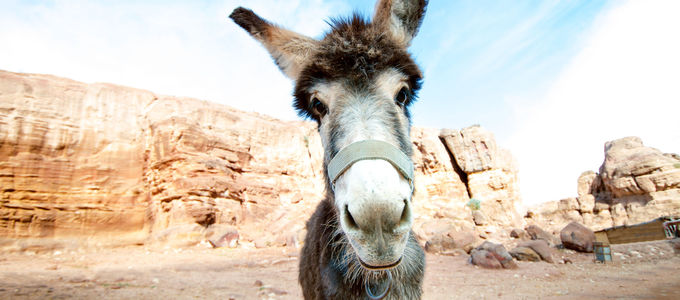The donkey, that’s me
Jesus knew exactly what He was doing when He chose His mount to enter Jerusalem. What’s more, He sent signals right up to our own time. Here is a reflection on the theme of Palm Sunday.

There is an anecdote from the mountains of South America: a congregation always giggled when the events of Palm Sunday were read out from the Bible. The pastor went and asked the people who translated the New Testament into the local language.
It turned out that this language does not have a word for donkey. The translators described it as “a furry animal with long ears”. The local people, however, knew only one species of this kind: they saw Jesus hopping into Jerusalem on a rabbit.
Of dubious reputation
Now, a donkey trotting over palm branches through the middle of a cheering crowd is not exactly the prime example of a serious mount—at least not nowadays. The poor four-legged creatures have a notorious reputation. They are said to be stupid, stubborn, and lazy. Even in ancient Greece, the donkey did not have the best reputation: it was regarded as a symbol of unbridled carnal lust, for example.
Why did such an animal play such an important role in Jesus’ entry into Jerusalem? Why did Jesus specifically send the disciples to get Him a donkey? When the Jews saw Him, they immediately understood the sign He was sending by His choice of mount.
A signal that made an impact
Jesus’ contemporaries were certainly aware of the prophecy found in Zechariah 9: 9: “Behold, your King is coming to you.” And His mount was so important that its nature is verbally driven into the listeners’ heads: a donkey (chamor), according to the basic Hebrew text, a young, strong donkey stallion (ajir), the purebred son of a she-ass (baen atonot).
Verse 10 tells us why this is so important: the donkey is not a horse. It is not the kind of war horse that is usually seen along with chariots and bows. Its rider will not come in the thick of battle, but “He shall speak peace to the nations”. He is not a tyrant, but the king of peace. His mount identifies Him as humble and gentle, as just and helpful.
Not stupid
Let us go back in time and take a look where a donkey first appears in the life story of Christ. Admittedly, not in the gospels, but in Christian tradition the animal is found at the feeding trough in the stable where Jesus first saw the light of day. It was put there by way of a word of prophecy: “The ox knows its owner and the donkey its master’s crib,” it says in Isaiah 1: 3.
Another leap forward takes us into the second century AD: someone scratched a piece of graffito in plaster on the wall of a house in Rome. It reads “Alexamenos worships his god”. This is the first pictorial representation of Jesus: it shows the crucified Jesus as a donkey-headed figure. Traditional interpretation says that the graffito was a parody of the crucifixion. Some theologians maintain it may have been a self-portrayal of Christians: just as Jesus, as the innocent Lamb, takes on the sins of the world, the ancient beast of burden carries the burden of the world.
Plodding on courageously
So the furry animal with the long ears from the opening anecdote looks very different. And we can better understand why Jesus moves through the history of the world in this way. Even today, He does not come along on a snorting war horse, but on a poor little donkey. And that’s me, the believer.
It takes courage to see oneself in this way. It takes courage to be humble and to serve, to be meek and peaceable, and to be patient and have the strength to endure. We confess our stubbornness and foolishness before the cross that makes us righteous. And we know at which manger our soul finds nourishment for eternal life.
Certainly, this donkey can also be a little stubborn in the sense that it does not allow itself to be led astray no matter how jubilant the people along the way are, as on Palm Sunday, or no matter how jeering they are, as on Good Friday.
Photo: tibor13 - stock.adobe.com




